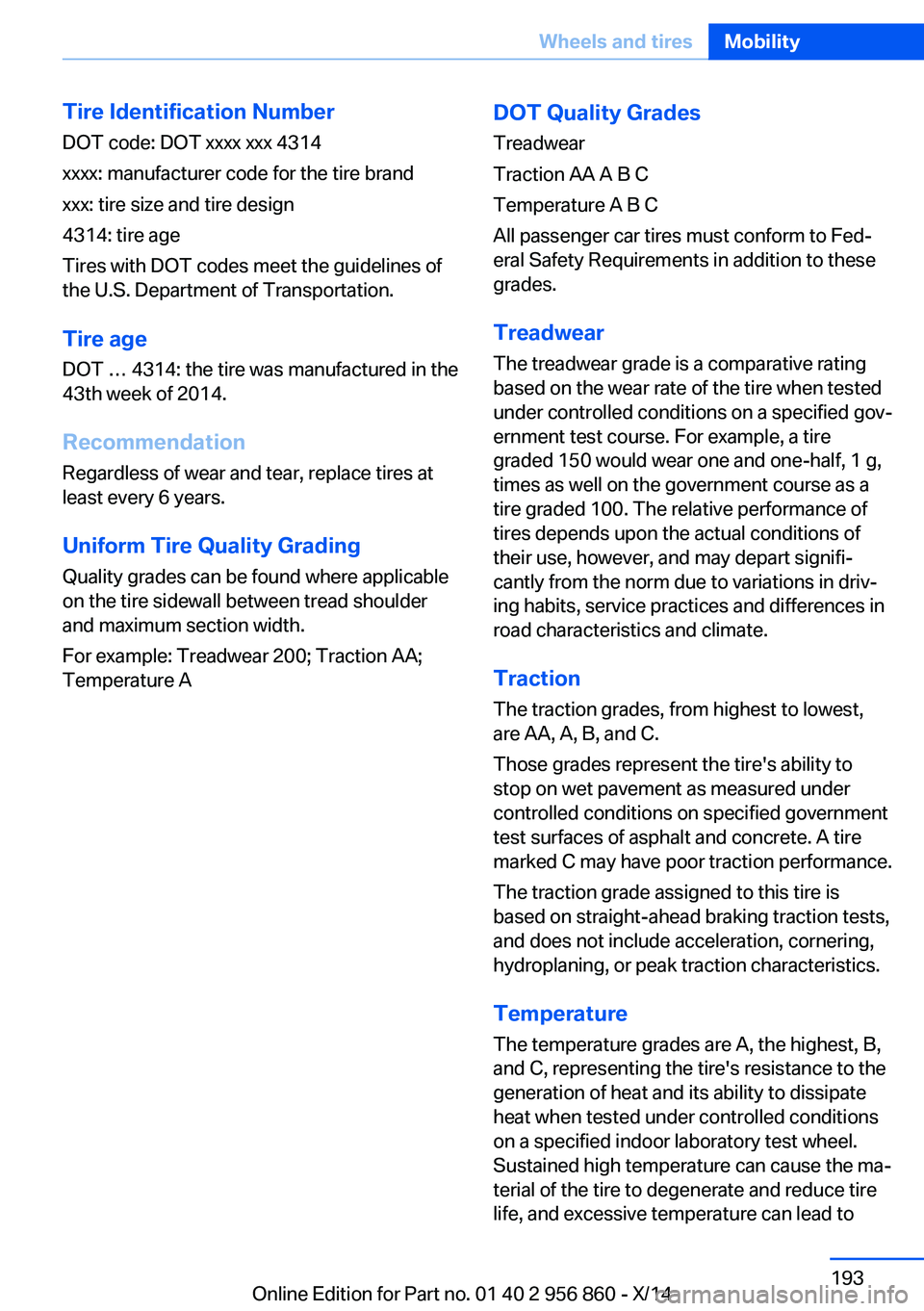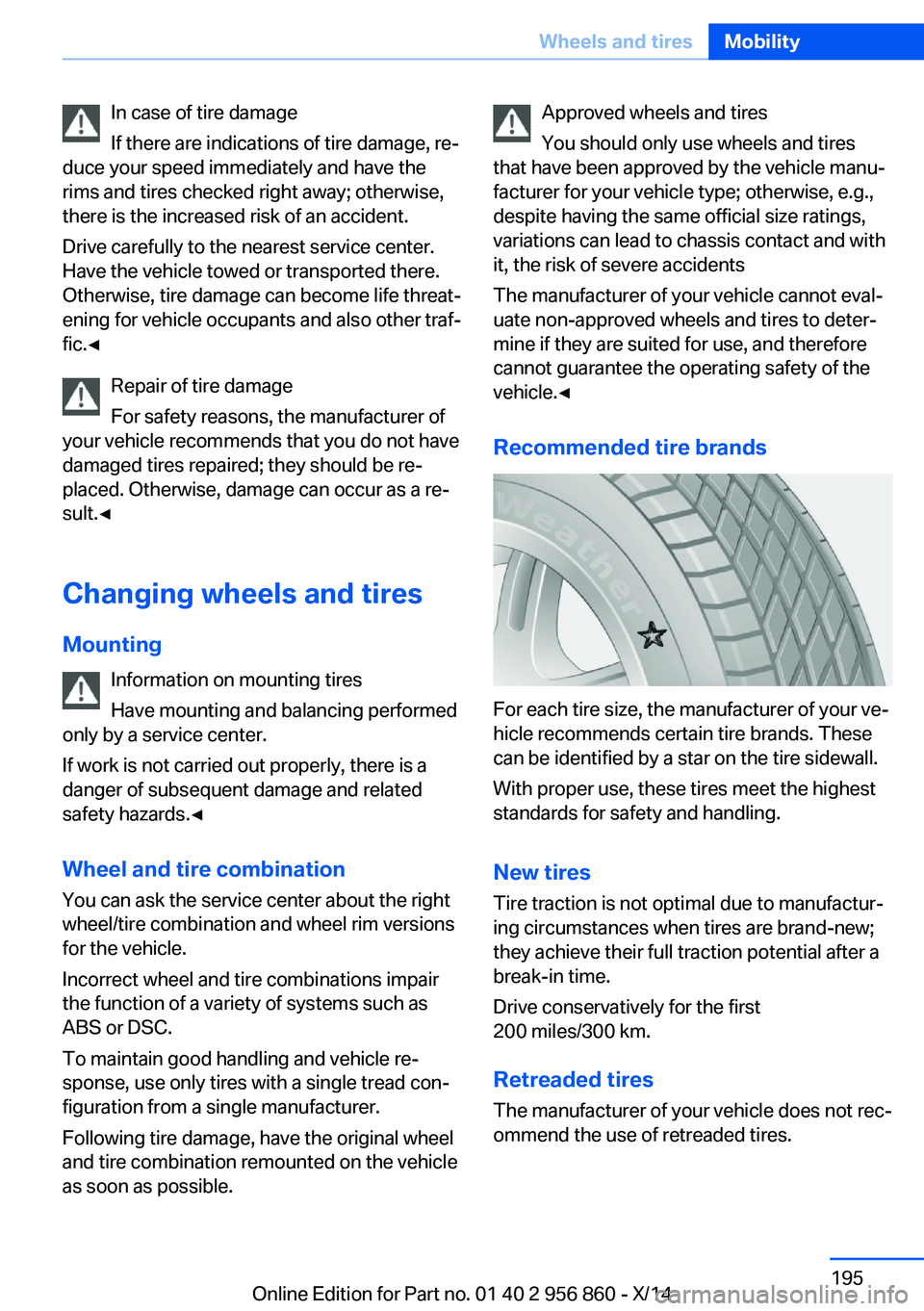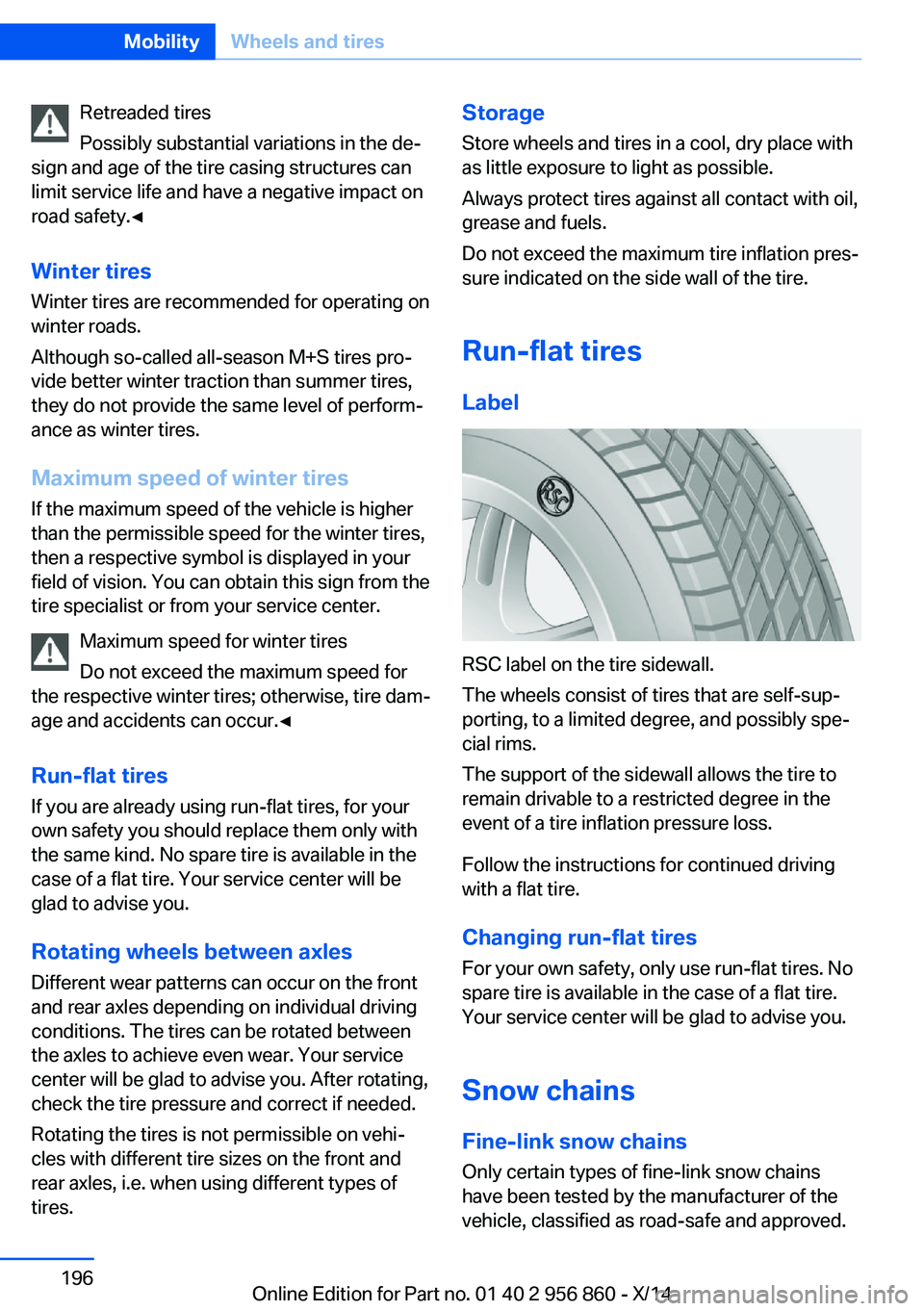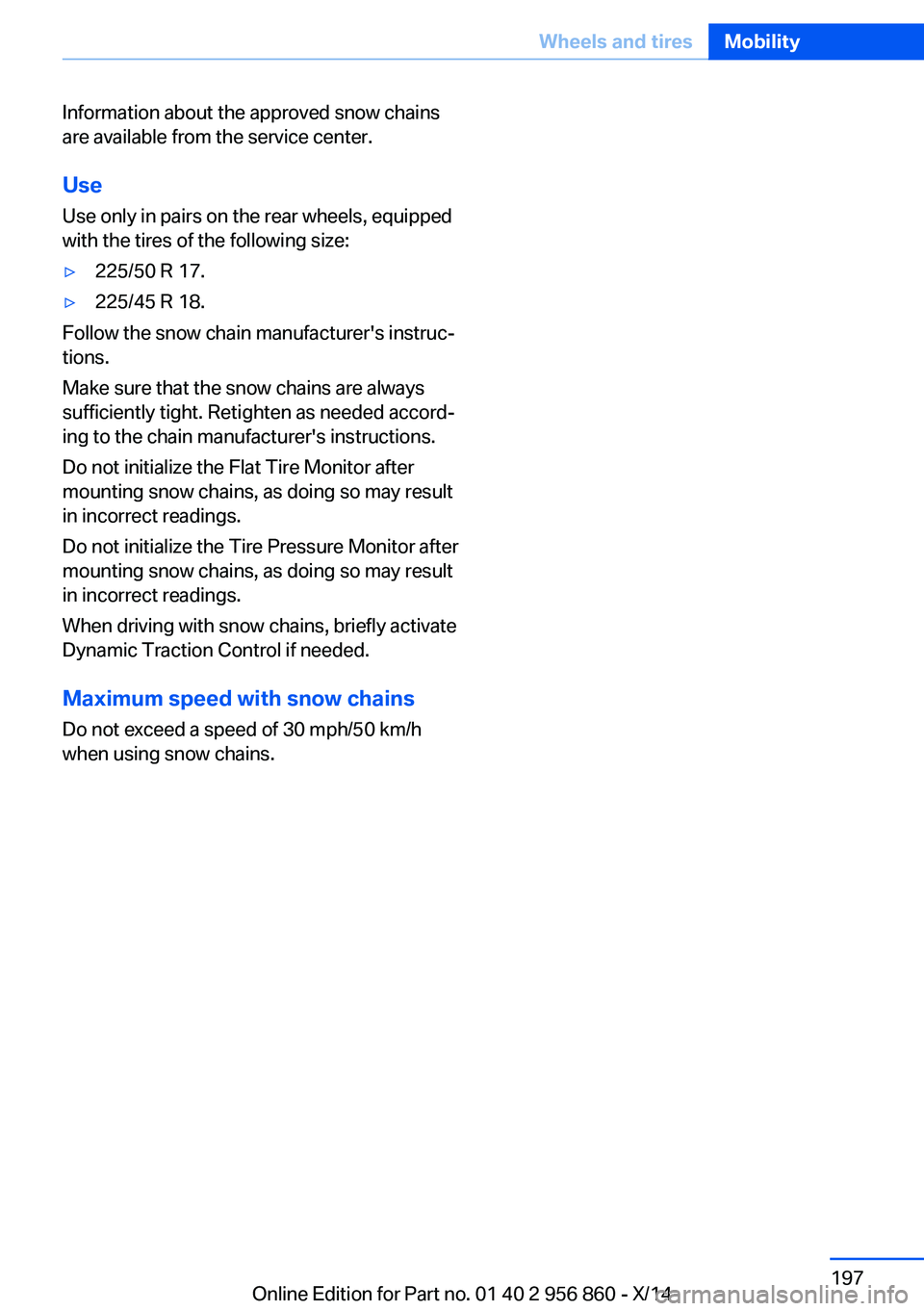2014 BMW 435I CONVERTIBLE wheel size
[x] Cancel search: wheel sizePage 196 of 244

Tire sizePressure specifications
in bar/PSI
Specifications in
bar/PSI with cold
tires
225/45 R 18 91 Y
RSC
225/50 R 17 94 H
M+S RSC
2.6 / 383.1 / 45225/45 R 18 95 V
M+S XL RSC
2.9 /423.4 / 49Front: 225/45 R 18
91 Y RSC
Rear: 255/40 R 18
95 Y RSC
2.6 / 38
-
-
2.8 / 41
Front: 225/40 R 19
89 Y RSC
Rear: 255/35 R 19
92 Y RSC
2.8 / 41
-
-
3.1 / 45
Front: 225/35 R 20
90 Y XL RSC
Rear: 255/30 R 20
92 Y XL RSC
3.0 / 44
-
-
3.5 / 51
Emergency wheel:
T 135/80 R 17 102
M
Speed up to a max. of
50 mph / 80 km/h
4.2 / 60
Tire identification marks
Tire size
245/45 R 18 96 Y
Seite 192MobilityWheels and tires192
Online Edition for Part no. 01 40 2 956 860 - X/14
245: nominal width in mm
45: aspect ratio in %
R: radial tire code
18: rim diameter in inches
96: load rating, not for ZR tires
Y: speed rating, before the R on ZR tires
Speed letter
Q = up to 100 mph, 160 km/h
R = up to 106 mph, 170 km/h
S = up to 112 mph, 180 km/h
T = up to 118 mph, 190 km/h
H = up to 131 mph, 210 km/h
V = up to 150 mph, 240 km/h
W = up to 167 mph, 270 km/h
Y = up to 186 mph, 300 km/h
Page 197 of 244

Tire Identification Number
DOT code: DOT xxxx xxx 4314
xxxx: manufacturer code for the tire brand
xxx: tire size and tire design
4314: tire age
Tires with DOT codes meet the guidelines of
the U.S. Department of Transportation.
Tire age
DOT … 4314: the tire was manufactured in the
43th week of 2014.
Recommendation
Regardless of wear and tear, replace tires at
least every 6 years.
Uniform Tire Quality Grading
Quality grades can be found where applicable
on the tire sidewall between tread shoulder
and maximum section width.
For example: Treadwear 200; Traction AA;
Temperature A
DOT Quality Grades
Treadwear
Traction AA A B C
Temperature A B C
All passenger car tires must conform to Fed‐
eral Safety Requirements in addition to these
grades.
Treadwear
The treadwear grade is a comparative rating
based on the wear rate of the tire when tested
under controlled conditions on a specified gov‐
ernment test course. For example, a tire
graded 150 would wear one and one-half, 1 g,
times as well on the government course as a
tire graded 100. The relative performance of
tires depends upon the actual conditions of
their use, however, and may depart signifi‐
cantly from the norm due to variations in driv‐
ing habits, service practices and differences in
road characteristics and climate.
Traction
The traction grades, from highest to lowest,
are AA, A, B, and C.
Those grades represent the tire's ability to
stop on wet pavement as measured under
controlled conditions on specified government
test surfaces of asphalt and concrete. A tire
marked C may have poor traction performance.
The traction grade assigned to this tire is
based on straight-ahead braking traction tests,
and does not include acceleration, cornering,
hydroplaning, or peak traction characteristics.
Temperature
The temperature grades are A, the highest, B,
and C, representing the tire's resistance to the
generation of heat and its ability to dissipate
heat when tested under controlled conditions
on a specified indoor laboratory test wheel.
Sustained high temperature can cause the ma‐
terial of the tire to degenerate and reduce tire
life, and excessive temperature can lead to
Seite 193Wheels and tiresMobility193
Online Edition for Part no. 01 40 2 956 860 - X/14
Page 199 of 244

In case of tire damage
If there are indications of tire damage, re‐
duce your speed immediately and have the
rims and tires checked right away; otherwise,
there is the increased risk of an accident.
Drive carefully to the nearest service center.
Have the vehicle towed or transported there.
Otherwise, tire damage can become life threat‐
ening for vehicle occupants and also other traf‐
fic.◀
Repair of tire damage
For safety reasons, the manufacturer of
your vehicle recommends that you do not have
damaged tires repaired; they should be re‐
placed. Otherwise, damage can occur as a re‐
sult.◀
Changing wheels and tires
Mounting Information on mounting tires
Have mounting and balancing performed
only by a service center.
If work is not carried out properly, there is a
danger of subsequent damage and related
safety hazards.◀
Wheel and tire combination
You can ask the service center about the right
wheel/tire combination and wheel rim versions
for the vehicle.
Incorrect wheel and tire combinations impair
the function of a variety of systems such as
ABS or DSC.
To maintain good handling and vehicle re‐
sponse, use only tires with a single tread con‐
figuration from a single manufacturer.
Following tire damage, have the original wheel
and tire combination remounted on the vehicle
as soon as possible.Approved wheels and tires
You should only use wheels and tires
that have been approved by the vehicle manu‐
facturer for your vehicle type; otherwise, e.g.,
despite having the same official size ratings,
variations can lead to chassis contact and with
it, the risk of severe accidents
The manufacturer of your vehicle cannot eval‐
uate non-approved wheels and tires to deter‐
mine if they are suited for use, and therefore
cannot guarantee the operating safety of the
vehicle.◀
Recommended tire brands
For each tire size, the manufacturer of your ve‐
hicle recommends certain tire brands. These
can be identified by a star on the tire sidewall.
With proper use, these tires meet the highest
standards for safety and handling.
New tires Tire traction is not optimal due to manufactur‐
ing circumstances when tires are brand-new;
they achieve their full traction potential after a
break-in time.
Drive conservatively for the first
200 miles/300 km.
Retreaded tires
The manufacturer of your vehicle does not rec‐
ommend the use of retreaded tires.
Seite 195Wheels and tiresMobility195
Online Edition for Part no. 01 40 2 956 860 - X/14
Page 200 of 244

Retreaded tires
Possibly substantial variations in the de‐
sign and age of the tire casing structures can
limit service life and have a negative impact on
road safety.◀
Winter tires
Winter tires are recommended for operating on
winter roads.
Although so-called all-season M+S tires pro‐
vide better winter traction than summer tires, they do not provide the same level of perform‐
ance as winter tires.
Maximum speed of winter tires If the maximum speed of the vehicle is higher
than the permissible speed for the winter tires,
then a respective symbol is displayed in your
field of vision. You can obtain this sign from the
tire specialist or from your service center.
Maximum speed for winter tires
Do not exceed the maximum speed for
the respective winter tires; otherwise, tire dam‐
age and accidents can occur.◀
Run-flat tires If you are already using run-flat tires, for your
own safety you should replace them only with
the same kind. No spare tire is available in the
case of a flat tire. Your service center will be
glad to advise you.
Rotating wheels between axlesDifferent wear patterns can occur on the frontand rear axles depending on individual driving
conditions. The tires can be rotated between
the axles to achieve even wear. Your service
center will be glad to advise you. After rotating,
check the tire pressure and correct if needed.
Rotating the tires is not permissible on vehi‐
cles with different tire sizes on the front and
rear axles, i.e. when using different types of
tires.Storage
Store wheels and tires in a cool, dry place with
as little exposure to light as possible.
Always protect tires against all contact with oil,
grease and fuels.
Do not exceed the maximum tire inflation pres‐
sure indicated on the side wall of the tire.
Run-flat tires Label
RSC label on the tire sidewall.
The wheels consist of tires that are self-sup‐
porting, to a limited degree, and possibly spe‐
cial rims.
The support of the sidewall allows the tire to
remain drivable to a restricted degree in the
event of a tire inflation pressure loss.
Follow the instructions for continued driving
with a flat tire.
Changing run-flat tires
For your own safety, only use run-flat tires. No
spare tire is available in the case of a flat tire.
Your service center will be glad to advise you.
Snow chains
Fine-link snow chains
Only certain types of fine-link snow chains
have been tested by the manufacturer of the
vehicle, classified as road-safe and approved.
Seite 196MobilityWheels and tires196
Online Edition for Part no. 01 40 2 956 860 - X/14
Page 201 of 244

Information about the approved snow chains
are available from the service center.
Use
Use only in pairs on the rear wheels, equipped
with the tires of the following size:▷225/50 R 17.▷225/45 R 18.
Follow the snow chain manufacturer's instruc‐
tions.
Make sure that the snow chains are always
sufficiently tight. Retighten as needed accord‐
ing to the chain manufacturer's instructions.
Do not initialize the Flat Tire Monitor after
mounting snow chains, as doing so may result
in incorrect readings.
Do not initialize the Tire Pressure Monitor after
mounting snow chains, as doing so may result
in incorrect readings.
When driving with snow chains, briefly activate
Dynamic Traction Control if needed.
Maximum speed with snow chains Do not exceed a speed of 30 mph/50 km/hwhen using snow chains.
Seite 197Wheels and tiresMobility197
Online Edition for Part no. 01 40 2 956 860 - X/14
Page 241 of 244

Servotronic 123
SET button, see Active Cruise Control, ACC 124
SET button, see Cruise con‐ trol 130
Settings, locking/unlock‐ ing 42
Settings on Control Dis‐ play 88
Settings, storing for seat, mir‐ ror 57
Shift paddles on steering wheel 73
Side airbags 96
Side View 137
Signaling, horn 14
Signals when unlocking 43
Sitting safely 52
Size 226
Smallest turning radius 226
Snow chains 196
Socket 157
Socket, OBD Onboard Diag‐ nostics 204
SOS button 215
Spare fuse 213
Specified engine oil types 202
Speed, average 86
Speed limit detection, com‐ puter 86
Speed limiter, display 83
Speed Limit Information 83
Speed warning 87
Split screen 23
SPORT+ - program, Dynamic Driving Control 122
Sport displays, torque dis‐ play, performance dis‐
play 87
SPORT program, Dynamic Driving Control 122
Sport program, transmis‐ sion 73
Sport steering, variable 121
Stability control systems 119 Start/stop, automatic func‐
tion 66
Start/Stop button 64
Start function during malfunc‐ tion 35
Starting the engine 65
Status control display, tires 101
Status information, iDrive 23
Status of Owner's Manual 6
Steering assistance 123
Steering wheel, adjusting 60
Steering wheel heating 60
Steptronic Sport transmis‐ sion 73
Steptronic transmission 72
Stopping the engine 65
Storage compartment in the rear 165
Storage compartments 163
Storage compartments, loca‐ tions 163
Storage, tires 196
Storing the vehicle 223
Summer tires, tread 194
Sun visor 157
Supplementary text mes‐ sage 80
Surround View 135
Switch for Dynamic Driv‐ ing 121
Switch-on times, parked-car ventilation 152
Switch, refer to Cockpit 14
Symbols 6
Symbols in the status field 23
T Tachometer 80
Tail lights 209
Technical changes, refer to Safety 7
Technical data 226 Telephone, see user's manual
for Navigation, Entertain‐
ment and Communication
Temperature, automatic cli‐ mate control 146, 148
Temperature display for ex‐ ternal temperature 81
Temperature, engine oil 80
Tempomat, refer to Active Cruise Control 124
Terminal, starting aid 217
Text message, supplemen‐ tary 80
Theft alarm system, refer to Alarm system 43
Thigh support 53
Through-loading system 161
Tilt alarm sensor 44
Time of arrival 86
Tire damage 194
Tire identification marks 192
Tire inflation pressure 188
Tire inflation pressure moni‐ tor, refer to FTM 104
Tire Pressure Monitor TPM 100
Tires, changing 195
Tires, everything on wheels and tires 188
Tires, run-flat tires 196
Tire tread 194
Tone, see user's manual for Navigation, Entertainment
and Communication
Tool 206
Top View 138
Total vehicle weight 227
Touchpad 21
Tow fitting 219
Towing 218
Tow lug, see tow fitting 219
Tow-starting 218
TPM Tire Pressure Moni‐ tor 100
Traction control 120 Seite 237Everything from A to ZReference237
Online Edition for Part no. 01 40 2 956 860 - X/14